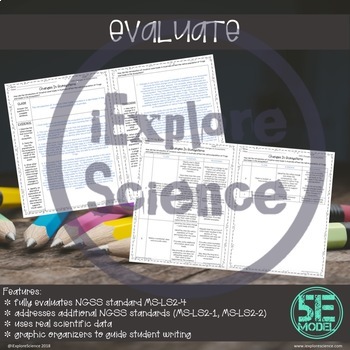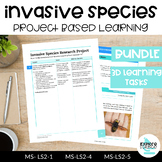Impacts of Invasive Species on Ecosystems: CER Assessment Task (NGSS MS-LS2-4)
- Zip
What educators are saying
Also included in
- Launch your ecosystems unit through the lens of invasive species - engaging students in real-world phenomena and authentic, project-based learning tasks. This bundle is ideal for teachers who want to add relevancy and excitement to their ecology unit by integrating modern-day environmental issues anPrice $17.00Original Price $25.50Save $8.50
- Teach ecosystems, the interactions within them, and the consequences of disruptions to their delicate balance by exploring invasive species - specifically, the arrival of "murder hornets" in the U.S. in 2020. This storyline sets students up to dig into concepts like ecosystem roles, ecosystem servicPrice $30.00Original Price $45.75Save $15.75
Description
Assess student understanding of changes in ecosystems through this phenomenon-based performance task. Students explore the case of the cane toad in Australia by analyzing real scientific data, drawing conclusions, and then using those conclusions to construct an argument using the Claim-Evidence-Reasoning essay structure. Through this phenomenon, students will explain how the introduction of an invasive species affects native populations in an area.
Learning Targets:
- Students will construct an argument to explain how changes in ecosystems [such as the introduction of invasive cane toads in Australia] can affect populations.
This lesson includes:
- 7 student pages
- teacher lesson guide
- answer keys + rubric
How can this lesson be used?
- assess student understanding of ecosystem dynamics through a phenomenon-based learning task
- engage students in the Science and Engineering Practice of Analyzing and Interpreting Data
How much class time will this take?
- This assessment task is designed to be completed within 1-2 60-minute class periods, depending upon how quickly students craft their C-E-R responses.
Is this NGSS-aligned?
This resource is part of a storyline designed to work toward the tagged Next Generation Science Standards. Because Performance Expectations are designed to assess learning by the end of the grade band, unit material may not fully assess every Performance Expectation tagged in the post.
This activity works toward student mastery of the Disciplinary Core Ideas, Science and Engineering Practices, and/or Crosscutting Concepts in the tagged Performance Expectations.
This activity engages students in the following Science and Engineering Practices:
- Analyzing and Interpreting Data
- Engaging In Argument From Evidence
This activity encourages students to think about the following Crosscutting Concepts:
- Change and Stability
- Cause and Effect
Prior Knowledge:
Students should be familiar with the idea of invasive species, as well as how ecosystems work – from resource availability to interactions in ecosystems to food chains/food webs. If students have not developed an understanding of some of these concepts, simply tailor the assessment expectations to those concepts that students were expected to master.
Can I see an example of how you structure your lessons and student materials?
Download my Let's Talk Trash Anchor Phenomenon freebieHERE</a>!
What if I have questions?
You can email me at nvantassel@iexplorescience.com with questions about resources or implementation. I'm happy to help!
Check Out These Related Resources
- 5E Activity Pack: Changes In Ecosystems
- Project Based Learning: Invasive Species Project
- Activity Pack: Field Notes Food Web
- Activity Pack: Where Have All The Tree Frogs Gone? Mystery
This activity bundle is part of a unit storyline that works towards these standards:
- MS-LS2-2 Construct an explanation that predicts patterns of interactions among organisms across multiple ecosystems. Emphasis is on predicting consistent patterns of interactions in different ecosystems in terms of the relationships among and between organisms and abiotic components of ecosystems. Examples of types of interactions could include competitive, predatory, and mutually beneficial.
- MS-LS2-4 Construct an argument supported by empirical evidence that changes to physical or biological components of an ecosystem affect populations. Emphasis is on recognizing patterns in data and making warranted inferences about changes in populations, and on evaluating empirical evidence supporting arguments about changes to ecosystems.
- MS-LS2-1 Analyze and interpret data to provide evidence for the effects of resource availability on organisms and populations of organisms in an ecosystem. Emphasis is on cause and effect relationships between resources and growth of individual organisms and the numbers of organisms in ecosystems during periods of abundant and scarce resources.
What Other Teachers Are Saying:
⭐️“Kids loved analyzing the graphs and seeing how the cane toad impacted the area being studied. We had just watched a video on this creature and they were thoroughly interested in the activity. Very clear and required analysis and careful reading of the graphs. Thanks for the great resource.”
⭐️ “This is a great resource! I used it in my ELA/Science block as a great way to connect the content areas!”
Terms Of Use:
Copyright © 2018 iExploreScience LLC. All pages of this product are copyrighted, and all rights are reserved by the author. You may not create anything to sell or share based on this packet. The product is created for the use of ONE teacher. Please do not share with colleagues. If they like the product, please send them to my TpT store. I appreciate your support with this request! You are permitted to share ONLY the cover image of this product on your blog or via social media as long as you link back to my product on TpT. Failure to comply is a copyright infringement and a violation of the Digital Millennium Copyright Act (DMCA). Clipart and elements found in this PDF are copyrighted and cannot be extracted and used outside of this file without permission or license. Intended for classroom and personal use ONLY.
*Note: NGSS is a registered trademark of Achieve. Neither Achieve nor the lead states and partners that developed the Next Generation Science Standards were involved in the production of this product, and do not endorse it.






